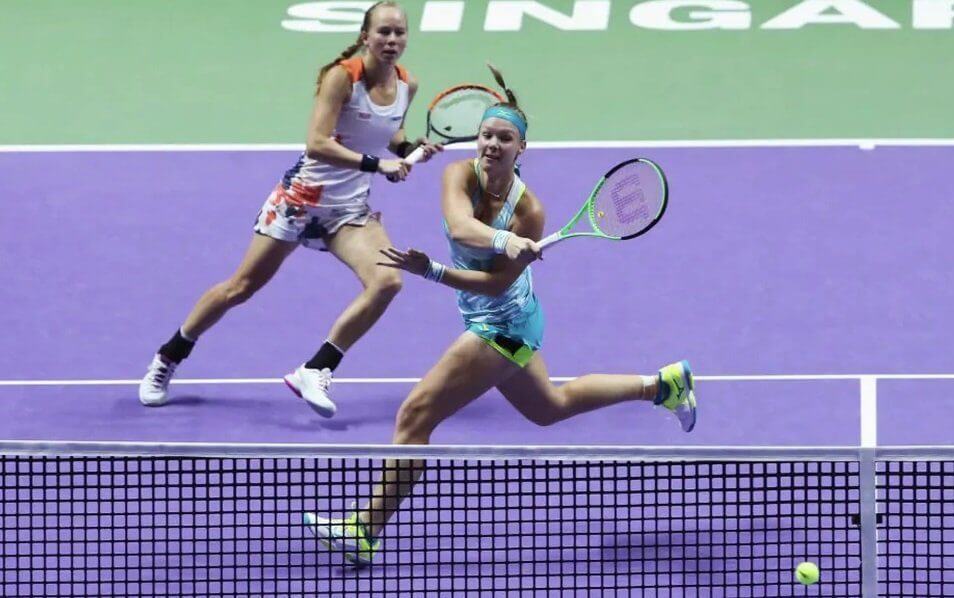Poaching and fake poaching are two great psych-out techniques in doubles. The primary purpose is to visually distract you, shorten your reaction time, and cause a forced, unforced error, even if you can think fast and get to the ball. When your opponents do it once, it gets into your head that they’ll do it again, so that before the server even starts the serving motion, you’re thinking more about your opponent than your own game…and that’s when errors happen.
So, what can you do when you come against an aggressive poacher? How can you deal with the emotional stress AND neutralize that player?
I’ve got six great tips you may already know but might not think of immediately when in a match…or maybe you only use one or two of them. Seeing them all in black and white helps get them embedded in your brain so that they are right there when you need them.
Lob your return of serve.
The lob is the most obvious tactic to use when dealing with this type of player. I’m not talking about a moonball, just one that’s high enough to clear the net player and deep enough – preferably landing near the corner behind the net player. (Be sure to use topspin as that will help bring the ball down before it goes long.) Lobbing keeps the ball away from the poacher and eventually forces them to back off the net a little bit, and if they don’t back off, then keep doing it. Lobbing also burdens the server to run every one of those lobs down, causing major frustration. I mean, how could it not? The opponent at net is now just standing around, unable to help, while their partner is getting worn out from running a marathon on the court.
Target the net player.
So, you have an opponent that reeeeally wants that ball? Then let ’em have it! Return down the line and/or right at the net player… especially to their backhand.
When you see that the net player is standing a little closer to the center line or is simply facing more toward the center line, they’re in poach-ready mode; their mind is more focused on the middle of the court than their alley. And that’s the perfect time to smack the ball right down their line or right at them. Hit it hard and keep it low with topspin, giving them only a fraction of a second to change their mindset from acting on a possible poach to reacting to a surprise missile.
I get it. Many players don’t like doing this because they don’t feel confident about their down-the-line shot or worry that their partner will get mad if they make an error. Or maybe they think it’s unsportsmanlike. Please repeat after me: It’s NOT unsportsmanlike. And even if you make the error, you’ll have your opponent worried that if you tried it once, you’ll do it again and probably get the point, so they’ll be more hesitant to poach.
Both partners stay back when returning serve.
Everyone has off days, and if you’re unintentionally setting your partner up as a target with short lobs, soft crosscourt or down-the-line shots, you can still do things to stay in the point until you can take advantage.
Have your partner come back to the baseline with you. I’m not a fan of this format, but sometimes, you’ve just got to do what you’ve got to do. Now, if the opponent poaches or picks off an attempted passing shot, you and your partner will have more time to react and move in for the next shot to stay in the point.
Stick to your plan.
Poachers really know how to get into our heads. They make us doubt our own ability to get the ball past them. We aren’t sure what they’ll do, so at the last second, we change our minds about the return and hit a bad shot.
Don’t change your mind about your shot your at the last second in the middle of the stroke. That’s exactly what they want you to do. Instead, pick a target and try to hit the best return you can. If they poach it, you learn your lesson and will try something different the next time.
Lob, lob, lob!
Play defensively and lob them to death! This is like the lob return, only now you lob constantly, corner to corner. Even a die-hard poacher will eventually have to move back or risk pissing off their worn-out partner. Players who are good up at net don’t like to play lobbers. If you can become that team that keeps lobbing, keeps moonballing, keeps getting the ball back, and lets your opponents make the mistake, you can neutralize these poaching players.
Switch sides with your partner.
If all else fails, and you’ve lost the first set badly (let’s say 1-6) with no signs that things will change in your favor, switch sides with your partner for the second set; you have nothing to lose. Sometimes the balls you hit on one side end up more poachable than those you hit on the other. For example, maybe your inside-out forehand keeps getting picked off on the deuce side, but it works well from the ad side. Switch sides and take that opportunity away from the poacher. Not only that, but this will change the look of the court from the opponent’s perspective and have them wondering what you’ll do next.
Use these tips and stay focused on your game, and you’ll show that aggressive poacher who’s the boss! And if there’s something else that works for you, please share it with us in the comments below!

